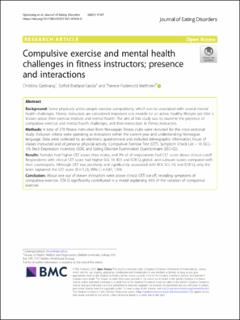| dc.contributor.author | Gjestvang, Christina | |
| dc.contributor.author | Bratland-Sanda, Solfrid | |
| dc.contributor.author | Mathisen, Therese Fostervold | |
| dc.date.accessioned | 2022-10-21T11:13:26Z | |
| dc.date.available | 2022-10-21T11:13:26Z | |
| dc.date.created | 2021-09-08T06:15:04Z | |
| dc.date.issued | 2021 | |
| dc.identifier.citation | Journal of Eating Disorders. 2021, 9, Artikkel 107. | en_US |
| dc.identifier.issn | 2050-2974 | |
| dc.identifier.uri | https://hdl.handle.net/11250/3027566 | |
| dc.description.abstract | Background: Some physically active people exercise compulsively, which can be associated with several mental health challenges. Fitness instructors are considered important role models for an active, healthy lifestyle; yet little is known about their exercise motives and mental health. The aim of this study was to examine the presence of compulsive exercise and mental health challenges, and their interaction, in fitness instructors.
Methods: A total of 270 fitness instructors from Norwegian fitness clubs were recruited for this cross-sectional study. Inclusion criteria were operating as instructors within the current year and understanding Norwegian language. Data were collected by an electronic questionnaire and included demographic information, hours of classes instructed and of personal physical activity, Compulsive Exercise Test (CET), Symptom Check List – 10 (SCL-10), Beck Depression Inventory (BDI), and Eating Disorder Examination Questionnaire (EDE-Q)).
Results: Females had higher CET scores than males, and 9% of all respondents had CET score above clinical cutoff. Respondents with clinical CET score had higher SCL-10, BDI and EDE-Q global- and subscale scores compared with their counterparts. Although CET was positively and significantly associated with BDI, SCL-10, and EDE-Q, only the latter explained the CET score (ß = 1.23, 99% CI = 0.87, 1.59).
Conclusion: About one out of eleven instructors were above clinical CET cut-off, revealing symptoms of compulsive exercise. EDE-Q significantly contributed in a model explaining 43% of the variation of compulsive exercise. | en_US |
| dc.language.iso | eng | en_US |
| dc.publisher | BioMed Central (BMC) | en_US |
| dc.relation.uri | https://jeatdisord.biomedcentral.com/articles/10.1186/s40337-021-00446-0?fbclid=IwAR1LI0qpupXL4nCPc6mH70V8ONtMxJddcg8-ZXx-9dYY0bKR8rhHDES8CwM | |
| dc.rights | Navngivelse 4.0 Internasjonal | * |
| dc.rights.uri | http://creativecommons.org/licenses/by/4.0/deed.no | * |
| dc.subject | dysfunctional exercise | en_US |
| dc.subject | compulsive exercise | en_US |
| dc.subject | disordered eating | en_US |
| dc.subject | depression | en_US |
| dc.subject | anxiety | en_US |
| dc.subject | physical activity | en_US |
| dc.subject | fitness centers | en_US |
| dc.subject | personal trainer | en_US |
| dc.subject | group instructor | en_US |
| dc.subject | eating disorders | en_US |
| dc.title | Compulsive exercise and mental health challenges in fitness instructors; presence and interactions | en_US |
| dc.type | Peer reviewed | en_US |
| dc.type | Journal article | en_US |
| dc.description.version | publishedVersion | en_US |
| dc.rights.holder | © The Author(s), 2021. | en_US |
| dc.subject.nsi | VDP::Medisinske Fag: 700::Klinisk medisinske fag: 750 | en_US |
| dc.source.volume | 9 | en_US |
| dc.source.journal | Journal of Eating Disorders | en_US |
| dc.identifier.doi | 10.1186/s40337-021-00446-0 | |
| dc.identifier.cristin | 1932233 | |
| dc.source.articlenumber | 107 | en_US |
| cristin.ispublished | true | |
| cristin.fulltext | original | |
| cristin.qualitycode | 1 | |

